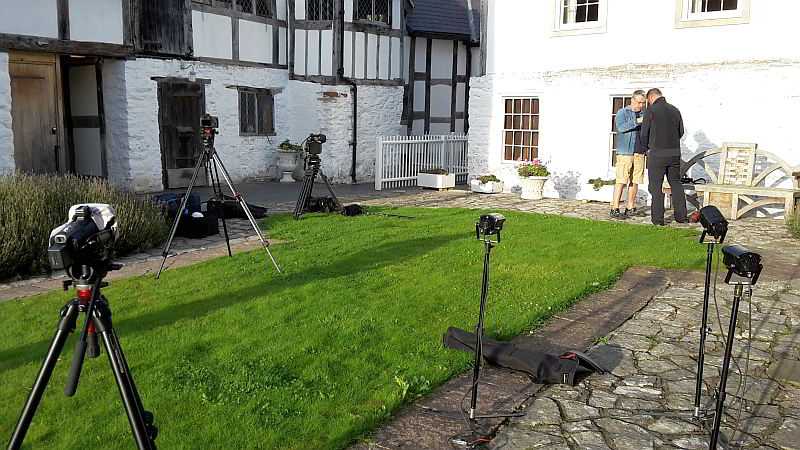Filming an infra red bat sequence
Filming an infra red bat sequence can be quite challenging. The welfare of the bats always comes first. Lesser horseshoe bats are protected by legislation. If you’d like to know a little more about them follow this link.
A few days ago we were in North Wales to film an infra red bat sequence. It was never going to be a pure wildlife cameraman type sequence. In its own way it was equally challenging. You might imagine a wildlife cameraman sequence being sumptuous shots of lesser horseshoe bats sweeping past the lens in slow motion. Perhaps they’d pluck a moth out of the air right in front of the camera. You might also expect to see them streaming from a roost hole. Not in this case. Our series is more about discovering wildlife in towns: encounters that most people might have if they are in the right place at the right time.

The aim was to introduce the presenter and contributor in the town square. This was always going to look best after the street lights had come on. Waiting for the street lights to come on meant cutting it fine with the bats. According to local knowledge they usually emerge shortly after sunset and disperse rapidly. There was very little time between filming the presenter meeting the contributor and the bats emerging. I must add, this is not the sort of sequence a wildlife cameraman films often.
The picture shows the scene behind the town square well before sunset. We had four cameras in use: the Sony F55, Sony FS7, Sony NX30 and Canon 5D. The 5D was on hire, optimised for infra red filming. Sony’s NX30 has native infra red filming. Firstly, the easy bit. I filmed general set up shots of the town square with street lights, car headlights and hotel decorative lights providing the illumination. The F55 was in Custom Mode with an ISO of 8000 for that. I also filmed the presenter walking around town on the way to the bat roost. Our director used the FS7 set up similarly for walk and talks and meeting the contributor. From the town square it was a short walk down an alley way onto a lawn area behind an old building. Bats emerge from a window opening high at the back of the building.
Lighting
Lighting was always going to be something of a compromise. We are a small mobile unit. Blitz lighting the whole area with infra red was never an option. We had three ‘normal’ IR lamps and a black source lamp. The latter was to light the presenter and contributor without their eyes looking like those of blood crazed demons. Slightly modified car batteries and large Sony camera batteries provided the power source. One of the things we found filming an infra red bat sequence was that expert knowledge was not always spot on. Bats had already emerged by the time we had finished the set up filming. In fact, contrary to flying off into the park, they were flying back and forward through the alley into the garden. If we had know this I suspect we would have changed the sequence, because bats fluttering around heads looks great on video. Key cameras were now the Canon 5D IR and the NX 30. I used the 5D to film the presenter and contributor, while the director moved lights around for best placement. Don’t forget, this, to us, was in the dark. It was pretty black away from the street lights, and normal lighting was strictly forbidden in proximity of the bats.
It’s a mystery
Quite how a sequence emerged from the mayhem I’m still not sure. But it did. A Canon 5D is not an easy beast to use without the aid of some sort of handling device. In the dark you have a bright screen in IR black and white staring at you, so hitting focus is challenging to say the least. The lens was supplied without a hood, and not having time to fashion one I had flare streaming in from all of the IR lights. In context it sort of looks OK, but I’d prefer it were not there. Digital flare can be produced in the edit if you really want it! The NX 30 was held by the presenter, so although I haven’t seen that footage it could turn out to be an inspirational idea. What I remember was very few bats emerging from the building, but bats in shot as the presenter and contributor spoke about them.
The result
Although it felt like mayhem at the time, the director reports that we nailed it. That is always music to my ears. Ask any wildlife cameraman. Filming an infra red bat sequence, certainly the whole thing in one bash, is not easy. It was fun though. Just can’t wait to see the sequence cut.
